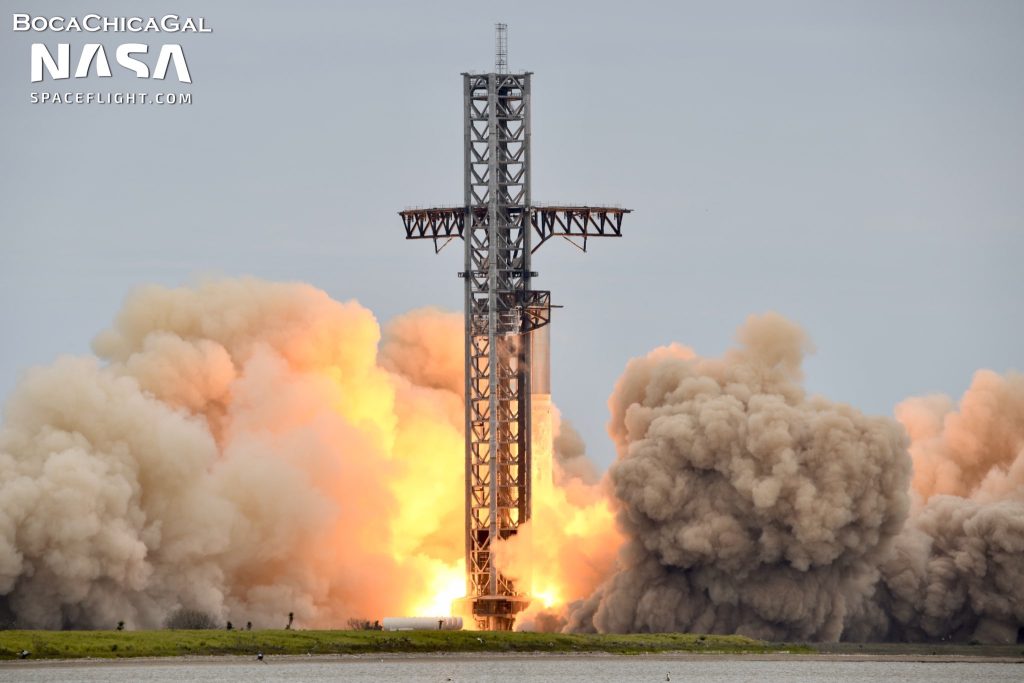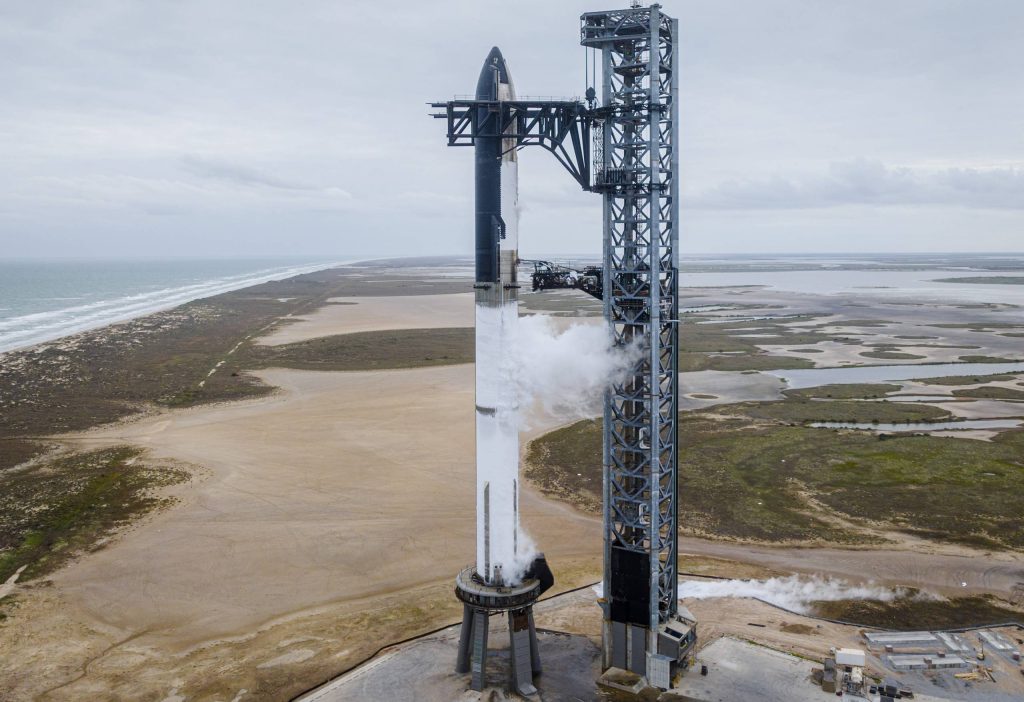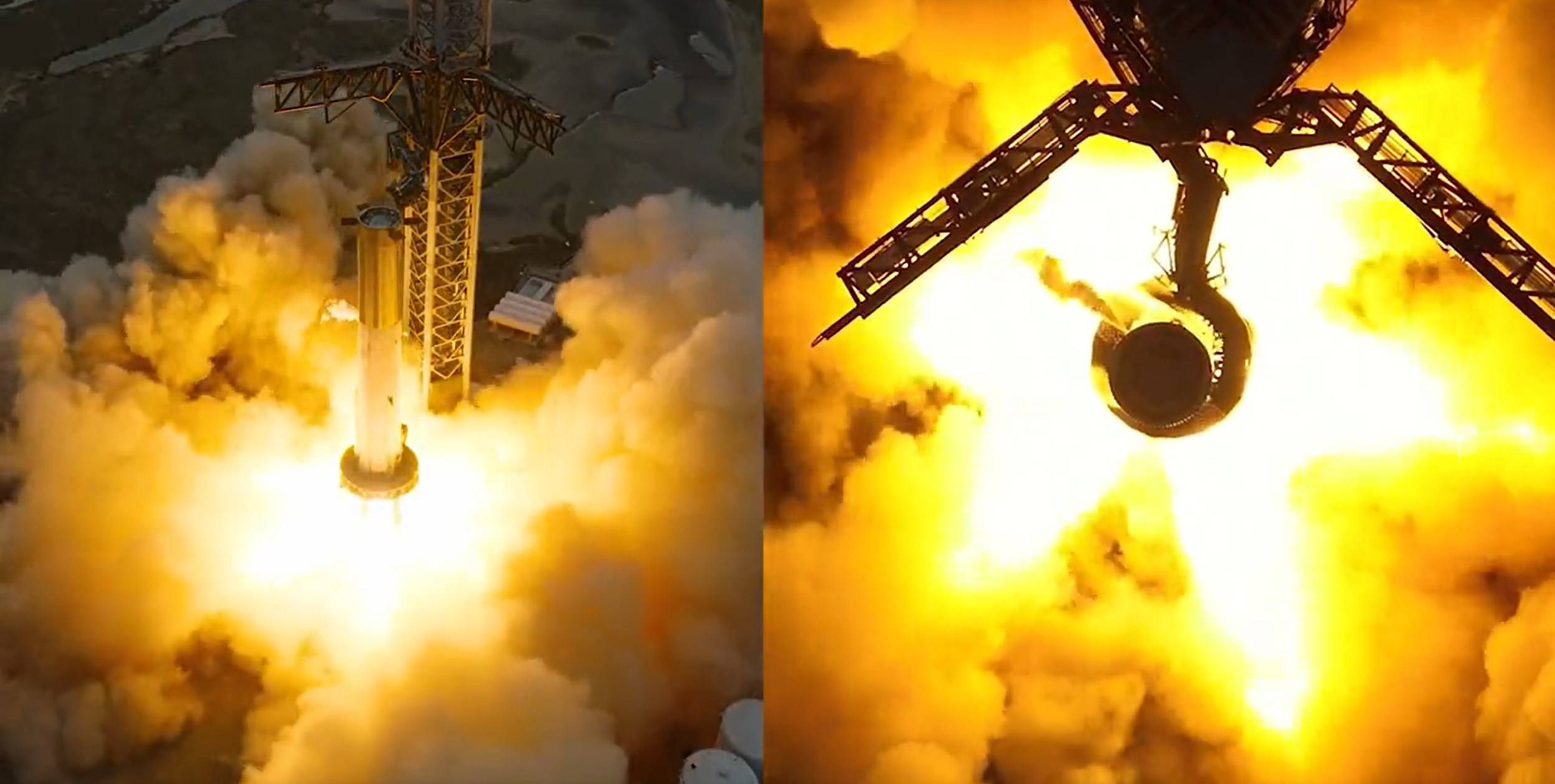SpaceX’s Starship rocket has survived a record-breaking engine test – potentially the most powerful static fire in the history of rocketry.
According to CEO Elon Musk, Super Heavy Booster 7 (B7) ultimately ignited 31 of its 33 Raptor engines. One engine was manually disabled “just before” the static fire, while the other faulty engine automatically shut down while attempting to ignite. The other 31 Raptors, however, completed a “full duration” static fire that lasted about five seconds. Musk says that even with two engines disabled, those that remained were “still enough…to reach orbit” – an excellent result despite the static fire’s imperfections.
Most importantly, Super Heavy Booster 7 survived the test without catching fire, exploding, or popping its tanks. To partially counteract the thrust of its Raptor engines, the rocket’s tanks were filled with some 3000 tons (6.6M lbs) of liquid oxygen and methane propellant. The stool-like orbital launch mount (OLM), which also survived the test in one piece, held Starship down with 20 clamps to counteract any remaining thrust. From SpaceX’s perspective, the fact alone that its only orbital-class Starship launch site survived the ordeal is likely enough for it to consider the static fire a success. But the test was much more than that.
Incinerating rocket records
Despite losing two Raptors, SpaceX still broke the all-time record for the number of rocket engines ignited simultaneously. That record was held by the Soviet N1 rocket, which launched four times with 30 NK-15 engines in the late 1960s and early 1970s. None of its test flights were successful, but N1 still set the record for the most thrust produced by a single rocket, generating up to 4500 tons (9.9M lbf) of thrust at liftoff.
Neither SpaceX nor CEO Elon Musk has confirmed it, reducing the odds that Super Heavy Booster 7 broke that historic thrust record. But it certainly could have. Each Raptor 2 engine can generate up to 230 tons (507,000 lbf) of thrust at sea level. Raptor is theoretically designed to throttle as low as 40%, or 92 tons (~200,000 lbf) of thrust. With 33 engines operating nominally at their minimum throttle setting, Super Heavy would have produced 3036 tons (~6.7M lbf) of thrust during today’s static fire – not a record.
For 31 Raptors to break N1’s thrust record, the average throttle setting would have had to be around 64% or higher – far from unreasonable. From a data-gathering perspective, a full-thrust static fire would be the most valuable 33-engine test SpaceX could attempt, but it would also be the riskiest and most stressful for the rocket and pad.
Former SpaceX executive Tom Mueller says that SpaceX broke N1’s record. Mueller is effectively the father of the Raptor engine, and likely still gets information straight from SpaceX engineers he used to work with. Still, one would expect SpaceX itself to proudly confirm as much if a rocket it built became the most powerful in history.
The most powerful rocket test in history?
Whether or not Starship became the most powerful rocket in history, it has likely become the most powerful rocket ever tested on the ground. The first stage of Saturn V produced around 3400 tons (7.5M lbf) of thrust during its first sea-level static fire in 1965. Likely contributing to its failure, N1’s booster was never static-fired. Other powerful rockets like the Space Shuttle and SLS use or used a combination of solid rocket boosters and liquid engines that cannot be tested together on the ground.
Unless SpaceX’s goal was a minimum-throttle static fire, Starship’s 31-Raptor static fire likely beat Saturn V’s record to become the most powerful ground test in the history of rocketry.
SpaceX’s next steps
While the 31 that did ignite appeared to perform about as well as SpaceX could have hoped, the two engines missing from February 9th’s historic Starship static fire have probably complicated the company’s next steps. To be fully confident in Starship’s ability to launch and fly a safe distance away from the launch site, SpaceX would likely need to complete a full 33-engine test. Meanwhile, Starship can’t fly until the Federal Aviation Administration approves a launch license, and the FAA could be stodgy enough to deny SpaceX a license without a perfect 33-engine static fire.
Alternatively, the FAA may accept that Starship could still safely launch and reach orbit while missing several Raptors. SpaceX could also guarantee that it will only allow Starship to lift off if all 33 engines are active, in which case a second 33-engine static fire attempt may not be necessary.


If SpaceX is happy with Booster 7’s 31-engine test results and isn’t too put off by any pad damage the test may or may not have caused, it will likely focus on finishing Starship 24. Ship 24 will then be transported back to the pad and reinstalled on top of Booster 7. SpaceX may choose to conduct another wet dress rehearsal or a static fire with the fully-stacked Starship, but it may also deem additional testing unnecessary.
Once all those tasks are completed, Ship 24 and Booster 7 will be ready to support Starship’s first orbital launch attempt. Prior to February 9th’s static fire, SpaceX CEO Elon Musk and COO/President Gwynne Shotwell agreed that Starship’s orbital launch debut could happen as early as March 2023. After today’s test, a March 2023 launch may be within reach.
Rewatch Super Heavy Booster 7’s historic static fire below.

